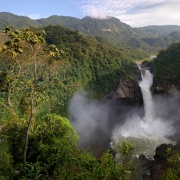REDD+ Finance: Where Next?
Over the past six weeks, Forest Trends’ REDDX and ODI’s Climate Funds Update have been exploring the state of REDD+ finance with input from Transparency International, the Tropical Forest Group, Ecosystem Marketplace and UNEP Finance Initiative. Here’s how these organizations can work together in the future to shine more light on this critical process.

Previous Coverage
Last year, we launced another series built on the findings of REDDX alone. Learn more about the initiative HERE
Part One: Tracking REDD+ Finance: Separating The Payers From The Posers provides an overview of the project and laysout its objectives.
Part Two: REDD Funding: The Horror Story That Isn’t examines the cumbersome accounting behind international aid in general and REDD finance in particular.
Part Three: Germany Beats Fast Start Finance But Sees Need For More Scale reviews the results of Germany’s Fast Start Finance period and reasons why they failed to meet their REDD+ commitment targets but succeeded in other areas.
Part Four: REDD+ Finance Leaves Pilot Projects In Limbo tells the story of a Ghanaian businessman seeking to launch a pilot project but is struggling to find funding from both international donors and private investors.
Part Five: The World Bank And The UN-REDD: Big Names, Narrow Focus provides a detailed overview of the biggest funding efforts of REDD+ as well as their interactions with each other.
Part Six: The Congo Basin Forest Fund Steps Up For REDD+ Piloting in DRC describes how the Congo Basin Forest Fund functions, who are the funders and lessons learned.
Part Seven: Brazil, Indonesia, And DRC Cooperate On Deforestation, See Future In REDD takes a high-level view of the impact of multilateral financing efforts on Brazil, Indonesia, and the Democratic Republic of Congo to date, and examines the prospects for REDD moving forward.
Over the past six weeks, Forest Trends’ REDDX and ODI’s Climate Funds Update have been exploring the state of REDD+ finance with input from Transparency International, the Tropical Forest Group, Ecosystem Marketplace and UNEP Finance Initiative. Here’s how these organizations can work together in the future to shine more light on this critical process.
29 August 2013 | In bringing together the views of a number of initiatives tracking REDD+ finance, this series has highlighted why there isn’t a single aggregate figure for global REDD+ finance flowing. Despite this, we are increasingly able to assess where finance is coming from, how it flows through different channels and funds to recipient countries and eventually to REDD+ projects and activities on the ground. But knowledge remains incomplete and we are still faced with challenges and gaps that make it difficult to make comprehensive and conclusive remarks about the state of REDD+ finance.
Few countries have centralised systems for tracking climate finance that arrives through a number of channels and instruments. REDD+ finance is no exception. Supporting the appropriate institutions for REDD+ finance tracking could include determining the right combination of civil society, academic and governmental institutions for this role as well as stronger collaborations with in-country REDD+ Focal Points to consolidate and report national data to the REDD+ Partnership’s Voluntary REDD+ Database (VRD). Forest Trends’ REDDX initiative, for example, has started to do this by working with local civil society partner organizations and REDD+ Focal Points to promote longer term in-country tacking capacity and more comprehensive data reported back to the REDD+ Partnership’s VRD.
2. Establish broader discourse and develop a protocol through which private finance for REDD+ can be better understood and tracked.
The road ahead
In addition to improving the way that REDD+ finance is monitored and tracked, more emphasis should be placed on sharing experiences and lessons with wider efforts to track climate finance and development aid. Gaining clarity over where money is going, through whom and how fast, is a first step to ensuring that the money does what it should, where it should. If donors and recipients of climate finance design transparent, comparable and accessible financial accounting systems, we will be able to more effectively track and monitor for accountability at a global or national level, by government or civil society.
This series of blogs on REDD+ finance intends to create a forum for debate and exchange of ideas. It should not be understood to reflect the views of Forest Trends, REDDX, ODI or Climate Funds Update.
Marigold Norman is Program Manager for Forest Trend’s Forest Trade and Finance Program. Her work focuses on tracking public and private funding delivered for Reducing Emissions from Deforestation and Degradation (REDD+) activities in thirteen REDD+ partner countries. Charlene Watson is a Research Officer at the Overseas Development Institute; her work focuses on the flows, sources and instruments of climate finance at both the national and international level.
Please see our Reprint Guidelines for details on republishing our articles.

